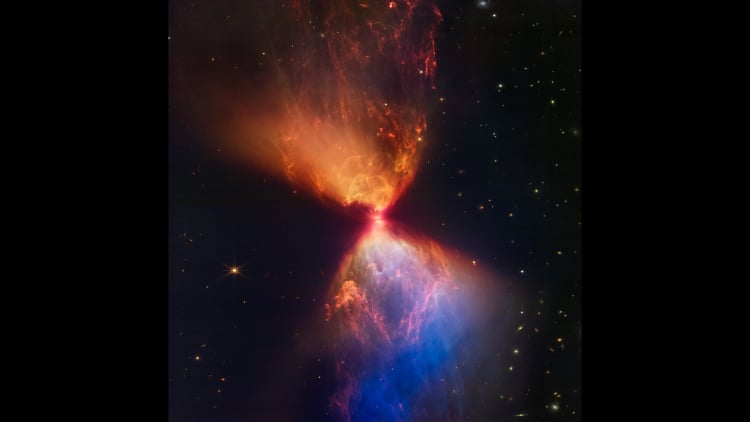
James Webb captures colorful lights of young protostar
The James Webb Space Observatory has captured new images of the extremely young protostar L1527. This star is only 100,000 years old, which is nothing compared to our Sun, which is over 4.5 billion years old. The youth of such objects is accompanied by intense activity as the future star absorbs surrounding material and, as it heats up, splashes it across the universe in the whimsical colors of a nebula.
Previously, the James Webb had already taken an image of the protostar L1527. In 2022, it captured an image using its Near Infrared Camera (NIRCam). The new image was taken with the MIRI instrument (Mid-Infrared Instrument), which can look further behind the veil of dust and gas surrounding the protostar. The image from MIRI is not as sharp and clear as from NIRCam, but it adds volume and new details to the picture.

NIRCam image of L1527 taken in 2022.
If you look closely, you can see that the protostar L1527 appears to be split in half. These are the traces of the gas and dust disk around the growing star. We see it edge-on. The star draws material from it and emits energy in the process of its accretion. The central area near the protostar is saturated with ionizing radiation and appears in the image as a red flash (to which Webb's optical system adds its artifacts—eight rays).
The image of L1527, captured in 2022 by NIRCam, shows the "flash" transitioning to a white glow—this is the outflow of dust and gas driven by the star's radiation. Further, the white "explosion" continues with a blue "flame." In Webb's images, this is how the traces of polycyclic aromatic hydrocarbons, the most abundant in the universe, appear. The star also initiates their outflow, resulting in the formation of a whimsical nebula in the shape of an hourglass. When the star accumulates its mass from the surrounding material, the accretion process will stop and take these wonderful views with it.
- Related News
- Astronomers have discovered an unusual radio galaxy with unusual structure: Why is it important?
- NASA releases video simulation of flight to Pillars of Creation
- Samples taken from Moon՛s far side for first time have been removed from capsule and sent for study
- NASA assigned SpaceX the task of landing ISS from space and will pay $843 million for it
- Powerful flare occurs in active part of Sun: What effect did it have on earth?
- China makes a historic breakthrough: Chang'e-6 probe delivers soil samples from the far side of the Moon
- Most read
month
week
day
- How to avoid smartphone overheating in hot weather? Useful tips 853
- New fraud scheme on Telegram: Scammers steal accounts and crypto wallets 823
- Xiaomi introduced mosquito repellent bracelet 815
- WhatsApp to end support for more than 40 smartphones: What are those models? 783
- What kind of opportunities are there in Armenia to do business? The guest of EconoMIX is Gagik Makaryan 766
- Best smartphones of June 2024 according to users 765
- Insider unveils full specifications of Samsung Galaxy Z Fold6 and Z Flip6 before presentation 714
- Best video games of first half of 2024 revealed 707
- WhatsApp gets new AI feature 700
- Samsung Galaxy Ring smart ring will monitor human snoring, measure body temperature 693
- Archive
